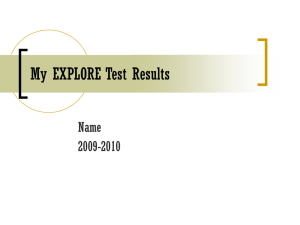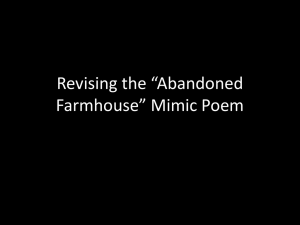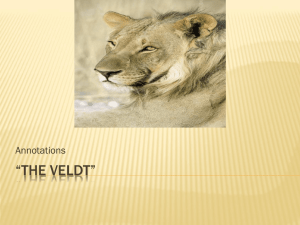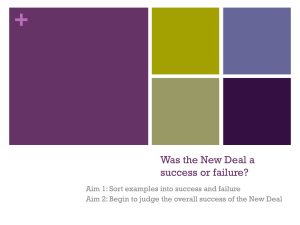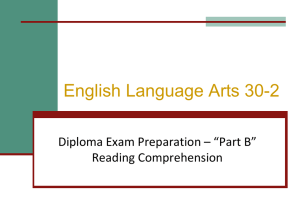File - Isles District 4
advertisement
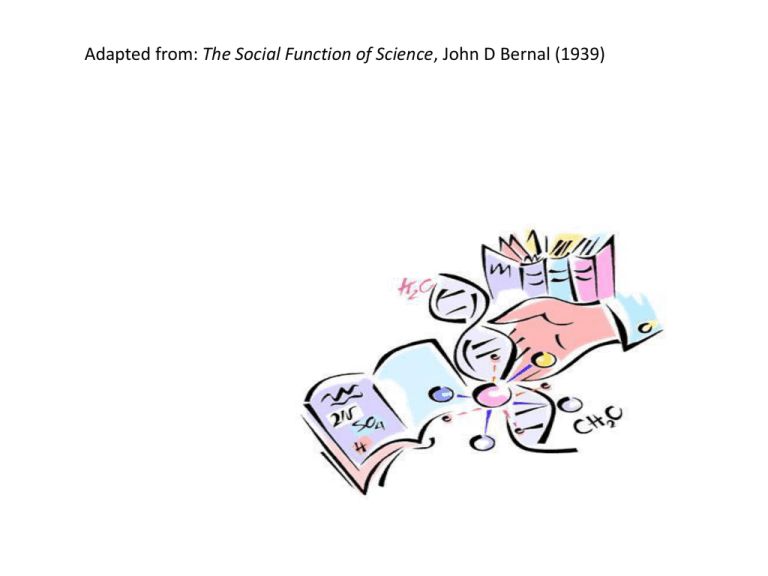
Adapted from: The Social Function of Science, John D Bernal (1939) 1. 2. 3. 4. 5. 6. The pioneers of the teaching of science imagined that its introduction into education would remove the conventionality, artificiality, and backward-lookingness which were characteristic; of classical studies, but they were gravely disappointed. So, too, in their time had the humanists thought that the study of the classical authors in the original would banish at once the dull pedantry and superstition of mediaeval scholasticism. The professional schoolmaster was a match for both of them, and has almost managed to make the understanding of chemical reactions as dull and as dogmatic an affair as the reading of Virgil's Aeneid. 7. The chief claim for the use of science in education is that it teaches a child something about the actual universe in 8. which he is living, in making him acquainted with the results of scientific discovery, and at the same time teaches him 9. how to think logically and inductively by studying scientific method. A certain limited success has been reached in the 10. first of these aims, but practically none at all in the second. Those privileged members of the community who have 11. been through a secondary or public school education may be expected to know something about the elementary 12. physics and chemistry of a hundred years ago, but they probably know hardly more than any bright boy can pick up 13. from an interest in wireless or scientific hobbies out of school hours. As to the learning of scientific method, the 14. whole thing is palpably a farce. Actually, for the convenience of teachers and the requirements of the examination 15. system, it is necessary that the pupils not only do not learn scientific method but learn precisely the reverse, that is, 16. to believe exactly what they are told and to reproduce it when asked, whether it seems nonsense to them or not. The 17. way in which educated people respond to such quackeries as spiritualism or astrology, not to say more dangerous 18. ones such as racial theories or currency myths, shows that fifty years of education in the method of science in Britain 19. or Germany has produced no visible effect whatever. The only way of learning the method of science is the long and 20.. bitter way of personal experience, and, until the educational or social systems are to make this possible, the best we 21. can expect is the production of a minority of people who are able to acquire some of the techniques of science and a 22. still smaller minority who are able to use and develop them. 23. Adapted from: The Social Function of Science, John D Bernal (1939) Vocabulary In line 2, highlight the noun that means adhering to accepted standards, as of conduct or tastes. In line 2, highlight the noun that refers to something that does not have a natural quality In line 3, highlight the noun that refers to a group of people or individuals having a strong interest in or concern for human welfare, values, and dignity. In line 3, highlight the adjective that describes something or someone that is conforming to ancient Greek and Roman models in literature or art, or to later systems modeled upon them. In line 4, highlight the noun that names a slavish attention to rules, details, etc. In line 4, highlight the adjective that describes something of, relating to, or in the style of the Middle Ages. In line 4, highlight the noun that names the system of theological and philosophical teaching predominant in the Middle Ages, based chiefly upon the authority of the church fathers and of Aristotle and his commentators. In line 5, highlight the adjective the describes asserting opinions in a doctrinaire or arrogant manner. In line 8, highlight the two adverbs that refer to logical reasoning. In line 8, highlight the noun that describes a method of research in which a problem is identified, relevant data are gathered, a hypothesis is formulated from these data, and the hypothesis is empirically tested . In line 10, highlight the term for a school in the U.S. that is a school that is maintained at public expense for the education of the children of a community and in England would be a private independent fee-paying secondary school . In line 12, highlight the noun that describes any system or device, as a cellular phone, for transmitting messages or signals by electromagnetic waves. In line 13, highlight the adjective that describes something that is readily or plainly seen, heard, perceived, etc.; obvious; evident. In line 16, highlight the noun that refers to pretending, professionally or publicly, to skill, knowledge, or qualifications he or she does not possess. In line 16, highlight the noun that describes the belief or doctrine that the spirits of the dead, surviving after the mortal life, can and do communicate with the living, especially through a person (a medium) particularly susceptible to their influence. In line 23, highlight the verb that means adjusted or modified fittingly. 1. 2. 3. 4. 5. 6. The pioneers of the teaching of science imagined that its introduction into education would remove the conventionality, artificiality, and backward-lookingness which were characteristic; of classical studies, but they were gravely disappointed. So, too, in their time had the humanists thought that the study of the classical authors in the original would banish at once the dull pedantry and superstition of mediaeval scholasticism. The professional schoolmaster was a match for both of them, and managed to make the understanding of chemical reactions as dull and as dogmatic an affair as the reading of Virgil's Aeneid. 7. The chief claim for the use of science in education is that it teaches a child something about the actual universe in 8. which he is living, in making him acquainted with the results of scientific discovery, and at the same time teaches him 9. how to think logically and inductively by studying scientific method. A certain limited success has been reached in the 10. first of these aims, but practically none at all in the second. Those privileged members of the community who have 11. been through a secondary or public school education may be expected to know something about the elementary 12. physics and chemistry of a hundred years ago, but they probably know hardly more than any bright boy can pick up 13. from an interest in wireless or scientific hobbies out of school hours. As to the learning of scientific method, the 14. whole thing is palpably a farce. Actually, for the convenience of teachers and the requirements of the examination 15. system, it is necessary that the pupils not only do not learn scientific method but learn precisely the reverse, that is, 16. to believe exactly what they are told and to reproduce it when asked, whether it seems nonsense to them or not. The 17. way in which educated people respond to such quackeries as spiritualism or astrology, not to say more dangerous 18. ones such as racial theories or currency myths, shows that fifty years of education in the method of science in Britain 19. or Germany has produced no visible effect whatever. The only way of learning the method of science is the long and 20. bitter way of personal experience, and, until the educational or social systems are to make this possible, the best we 21. can expect is the production of a minority of people who are able to acquire some of the techniques of science and a 22. still smaller minority who are able to use and develop them. 23. Adapted from: The Social Function of Science, John D Bernal (1939) For summary… The pioneers of the teaching of science were convinced they would make a difference. In line 2, underline and/or highlight the words that describe classical studies. In line 3, highlight the end result of the pioneers efforts. In lines 3 and 4, highlight what the “humanists” used for study and in lines 4 and 5, highlight or underline what they thought they would accomplish. In lines 4 and 5, highlight who was a match for both the pioneers and the humanists. In lines 7-9, highlight the chief claims for the use of science in education. In lines 9 and 10, highlight what success was accomplished. In line 10, highlight who may be expected to know something about the elementary physics and chemistry of a hundred years ago. In line 12, highlight who can pick up from an interest in wireless or hobbies out of school hours and have at least as much if not more. In lines 13 and 14, highlight what is said about the learning of the scientific method. In line 16, highlight what it is that is necessary for pupils to believe. In lines 18 and 19, highlight what fifty years of education in the method of Science has produced in Britain and Germany. In lines 19-20, highlight the only way of learning the method of science. In lines 20-22, what is the best we can expect until the educational or social systems make personal experience the best way to learn the method of science. 1. 2. 3. 4. 5. 6. The pioneers of the teaching of science imagined that its introduction into education would remove the conventionality, artificiality, and backward-lookingness which were characteristic; of classical studies, but they were gravely disappointed. So, too, in their time had the humanists thought that the study of the classical authors in the original would banish at once the dull pedantry and superstition of mediaeval scholasticism. The professional schoolmaster was a match for both of them, and has almost managed to make the understanding of chemical reactions as dull and as dogmatic an affair as the reading of Virgil's Aeneid. 7. The chief claim for the use of science in education is that it teaches a child something about the actual universe in 8. which he is living, in making him acquainted with the results of scientific discovery, and at the same time teaches him 9. how to think logically and inductively by studying scientific method. A certain limited success has been reached in the 10. first of these aims, but practically none at all in the second. Those privileged members of the community who have 11. been through a secondary or public school education may be expected to know something about the elementary 12. physics and chemistry of a hundred years ago, but they probably know hardly more than any bright boy can pick up 13. from an interest in wireless or scientific hobbies out of school hours. As to the learning of scientific method, the 14. whole thing is palpably a farce. Actually, for the convenience of teachers and the requirements of the examination 15. system, it is necessary that the pupils not only do not learn scientific method but learn precisely the reverse, that is, 16. to believe exactly what they are told and to reproduce it when asked, whether it seems nonsense to them or not. The 17. way in which educated people respond to such quackeries as spiritualism or astrology, not to say more dangerous 18. ones such as racial theories or currency myths, shows that fifty years of education in the method of science in Britain 19. or Germany has produced no visible effect whatever. The only way of learning the method of science is the long and 20.. bitter way of personal experience, and, until the educational or social systems are to make this possible, the best we 21. can expect is the production of a minority of people who are able to acquire some of the techniques of science and a 22. still smaller minority who are able to use and develop them. 23. Adapted from: The Social Function of Science, John D Bernal (1939) Summarizing… On the lines provided on the back of your text, write a 4-6 line summary of what you’ve just read and highlighted. You may refer back to the text as necessary. Multiple Choice… 1. The author implies that the ‘professional schoolmaster (line 4) has a. no interest in teaching science. b. thwarted attempts to enliven education. c. aided true learning. d. supported the humanists. e. been a pioneer in both science and humanities. 2. The author’s attitude to secondary and public school education in the sciences is a. ambivalent b. neutral c. supportive d. satirical e. contemptuous 3. The word ‘palpably’ (line 14) most nearly means a. empirically b. obviously c. tentatively d. markedly e. ridiculously 4. The author blames all of the following for the failure to impart scientific method through the education system except a. poor teaching. b. examination methods. c. lack of direct experience. d. the social and educational systems. e. lack of interest on the part of students. 5. If the author were to study current education in science to see how things have changed since he wrote the piece, he would probably be most interested in the answer to which of the following questions? a. Do students know more about the world about them? b. Do students spend more time in laboratories? c. Can students apply their knowledge logically? d. Have textbooks improved? e. Do they respect their teachers? 6. Astrology (line 17) is mentioned as an example of a. a science that needs to be better understood. b. a belief which no educated people hold. c. something unsupportable to those who have absorbed the methods of science. d. the gravest danger to society. e. an acknowledged failure of science. 7. All of the following can be inferred from the text except a. At the time of writing, not all children received a secondary school education. b. The author finds chemical reactions interesting. c. Science teaching has imparted some knowledge of facts to some children. d. The author believes that many teachers are authoritarian. e. It is relatively easy to learn scientific method.
